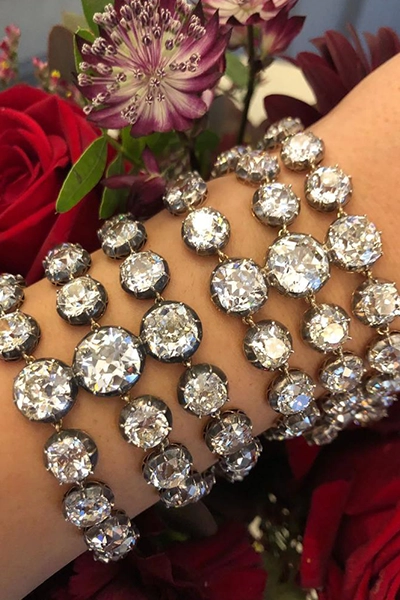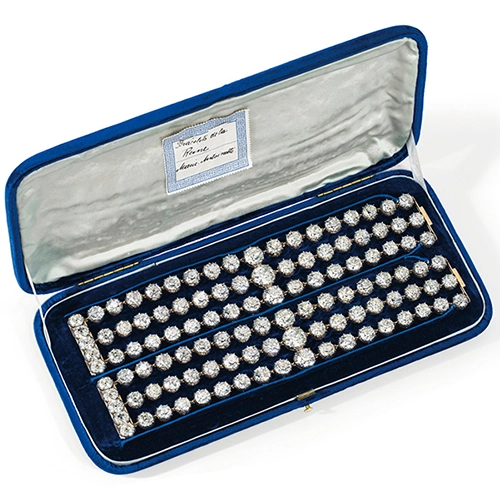29 November 2021
Does the future look bright for diamonds?
3 minutes
Marie Antoinette was the last Queen of France and her diamond bracelets have just sold for more than £6 million at auction. In our latest investments feature, Private Clients Director Julie Webb explores the post-pandemic diamond market with industry experts.
After being kept in the same family for more than 200 years, a pair of diamond bracelets that belonged to Marie Antoinette have sold at auction in Geneva for £6 million, more than double the pre-sale estimate.
Each bracelet comprises three strings of diamonds with 112 gems, each weighing 97 grams.
Marie Antoinette had stashed her jewels in a wooden chest before she was beheaded during the French Revolution in 1793. The bracelets were smuggled out of the country in a blue velvet box bearing the queen’s name and remained within her family for two centuries.
 |
(Image: Marie Antoinette’s bracelets – Credit: Christie’s)
Jewellery expert Patricia Law says diamonds “with such extraordinary provenance, rarity and beauty will always achieve the highest prices”.
She adds: “People are buying history – they want to own a piece of that person. Jewellery from collections owned by actress Elizabeth Taylor, the Duchess of Windsor, Princess Margaret and Jackie Kennedy Onassis have created great interest and fetched high prices.
“However, in the more general post-pandemic market, taste is changing among diamond lovers with consumers increasingly keen on buying rare, colourful ‘Fancy’ diamonds in pinks and blues along with traditional white stones.
“Ethically sourced synthetic diamonds, which came on to market a few years ago, add to the mix but whether investors are buying natural or synthetic diamonds they must always remember that fashions change, so it is always wise to buy a diamond because they love it.”
 |
What do we know about lab-grown diamonds?Synthetic diamonds are identical to mined diamonds with the same optical, physical, chemical and natural properties. A diamond would need to be tested for its origin if there is not an accompanying certificate. Lab-grown diamonds are not dug out of the ground so we lose the issue of diamond mining, but they still impact the environment, requiring energy to build a diamond ‘seed’ at very high heat. Established diamond company De Beers, which has been mining diamonds for more than two centuries, has invested in lab-grown diamonds. At first, the new investment and cost of production meant prices were high, but now the technology has improved and the diamonds have become cheaper than natural diamonds. (Image: The historic Marie Antoinette Diamonds – Credit: Christie’s) |
Patricia Law’s top tips on how to buy diamonds
Considerations when buying a diamond should be attention to colour, clarity, shape (a classic round, brilliant-cut diamond will always stay in fashion) and proportion. A diamond often comes with a certificate that comments on these factors which give diamonds their brilliance and sparkle.
- Auctions are best for buying in the second-hand market.
- When buying retail, if you need to sell the diamond in the immediate future it will mean selling it on the second-hand market where the price is invariably lower.
- Buy what you like – whether you are buying to invest or want to pass down a gem to children. Buyers often have to wait a while to get their money back, so it is best to be able to enjoy the item.
Bonhams Auctioneers’ jewellery predictions
Bonhams anticipates continued strength in the market for exceptional quality and extremely rare coloured, unheated gemstones. With many mines becoming depleted, the market for top-quality gemstones sees a sustained and continued growth.
When it comes to pink diamonds, with less availability resulting from the exhaustion and closure of the Argyle mine in Australia, Bonhams anticipates demand will increase for this hotly contested gem. Since the year 2000 the price of the Argyle Pink Diamonds Tender has increased 500 percent.
Against this backdrop, the market for Fancy Pinks projects a strong area of growth in 2021 and beyond.
Patricia Law has more than 30 years’ experience in the jewellery market and is a Fellow of the Gemmological Association and regional valuer for Bonhams Auctioneers. See Bonhams’ Jewellery 2021 predictions in full at bonhams.com
Jewellery Valuations and Insurance
Whether you are a long-term collector or new to buying diamonds, remember the importance of regular valuations.
Insurers recommend that you obtain a jewellery valuation at least every five years, preferably three in today’s market. But check your schedule and policy wording for specific requirements.
Insurers will require any valuation to be for “insurance purposes” and for retail value. You should also consider how you would replace your jewellery in the event of a loss. Would you want a brand new replacement with a modern equivalent (New Replacement Value) or would you prefer an antique replacement (Antique Replacement Value)? Ensure the items are photographed, kept in good condition and your documentation is in a safe place to help in the event of a claim. It’s a good idea to send a copy of your valuations to your broker, whether or not the insurer requires it.
To speak to Howden about insuring your jewellery call 020 8256 4901 or email privateclients@howdeninsurance.co.uk.
Upcoming jewellery auctions
Bonhams
London Jewels
December 2, 2021
New Bond Street, London
Visit bonhams.com
Knightsbridge Jewels
December 8, 2021
Visit bonhams.com
Christie’s
Luxury Week online
From end November to December 10, 2021
Visit christies.com
Phillips
Jewels & More: Online Auction
New York
December 2-8, 2021
Visit phillips.com
